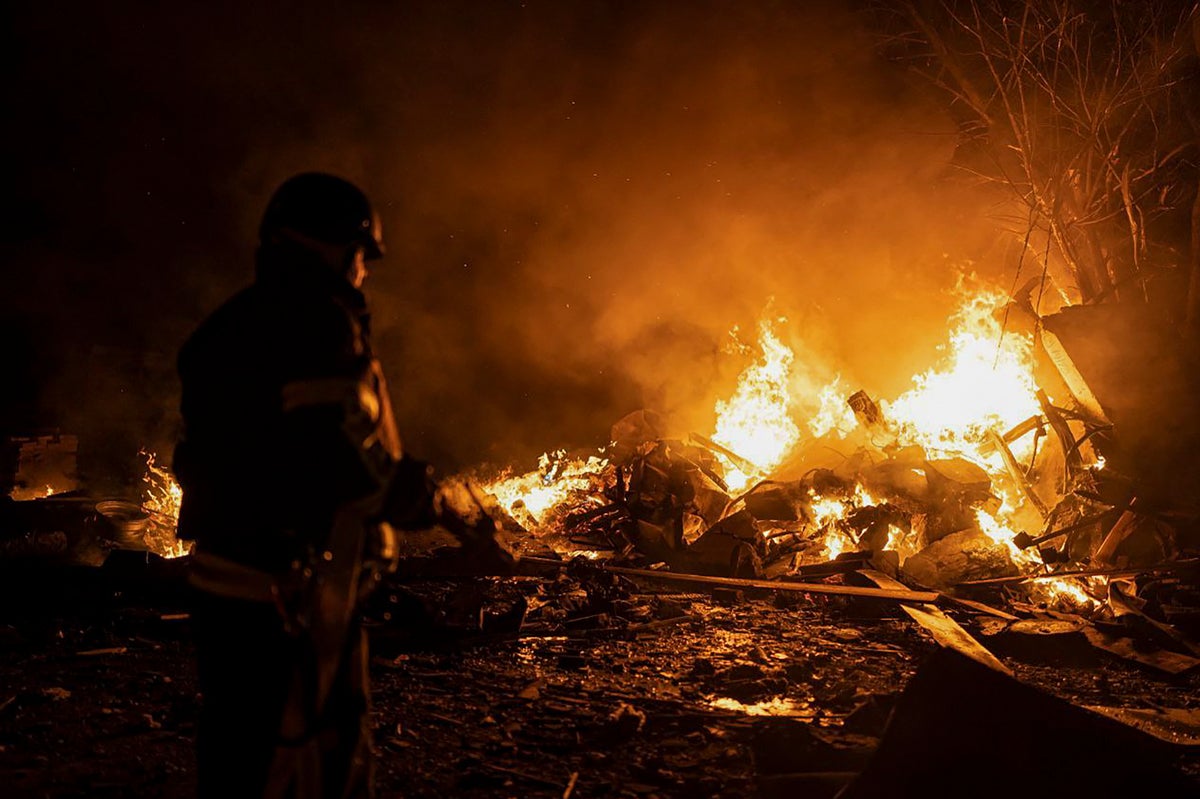
Ukraine claims to have shot down a volley of Russian hypersonic missiles – one of Moscow‘s most potent weapons – during an attack on the capital Kyiv described as “exceptional in density”.
It is the first time Ukraine has claimed to have struck down multiple Kinzhal – which means “dagger” in Russian – missiles in one go. If confirmed it would be a demonstration of the effectiveness of Kyiv’s newly deployed Western air defences in helping thwart some of Russia’s most advanced weaponry. President Vladimir Putin has previously claimed that the Kinzhal would be able to “overcome all existing and ... prospective anti-aircraft and anti-missile defence systems”.
Officials claimed to have intercepted all six of the Kinzhal fired at it, as part of a volley of 18 missiles launched by Moscow’s forces in the early hours of Tuesday morning. Video footage showed air defences destroying targets over the capital, with the barrage also including cruise missiles and kamikaze drones.
The overnight attack on Kyiv was “exceptional in its density – the maximum number of attacking missiles in the shortest period of time”, said Serhii Popko, the head of the Kyiv military administration. Kyiv authorities said three people were wounded by falling debris.
“Another unbelievable success for the Ukrainian air forces!” Oleksii Reznikov, the defence minister, said on Twitter.
If the Kinzhal claims are confirmed as accurate, it highlights the role that modern Western weaponry – such as the US-made Patriot surface-to-air missiles defence system – can have in Ukraine repelling missile assaults in what would be a blow to the Kremlin.
Russia, always keen not to lose face in the propaganda war that surrounds the battlefield action, itself claimed to have destroyed a Patriot missile battery in Kyiv using a Kinzhal.
US sources told CNN that the system may have to be withdrawn due to damage. An assessment was ongoing, they added.
Reports last week suggested that Russia has previously tried to destroy Patriot systems, that arrived in Ukraine a few weeks ago. Russia also said that Tuesday’s attack had hit all its targets, which it claimed had been aimed at Ukrainian fighting units and ammunition storage sites.
Kinzhal missiles, which travel on a ballistic trajectory and have a potential maximum speed of more than 7,000mph (11,000km/h), can carry conventional or nuclear warheads up to 1,200 miles (2,000km). Russia used the weapon in warfare for the first time in Ukraine last year and has only acknowledged firing the missiles on a few occasions. Mr Putin has frequently touted it as proof of world-beating Russian military hardware, capable of taking on Nato. Acknowledging the use of the weapon last March, US President Joe Biden called the Kinzhal a “consequential weapon” and that it is “almost impossible to stop it”.
With Ukrainian forces preparing to go on the offensive against Russia’s invasion for the first time in six months, Moscow is now launching long-range air strikes at the highest frequency months. It has launched eight drone and missile volleys so far this month, compared to weekly during the winter and a lull in March and April. Kyiv says it has been shooting most down.
This latest assault followed President Volodymyr Zelensky’s trip to various European capitals – London, Berlin, Paris and Rome – as he calls on Western allies to send Kyiv more advanced weaponry and fighter jets and speed up deliveries. Mr Zelensky met with Rishi Sunak on his mini-European tour and the prime minister said during a trip to Iceland on Tuesday that he would discuss the issue with European allies.
“I’ll be talking to other countries, making sure that we continue to support Ukraine, give them the support that they need to defend themselves against Russian aggression, and also start thinking about the longer-term security arrangements that we will want to put in place to support Ukraine in the long term,” Mr Sunak said, with him due to meet other leaders at the Council of Europe Summit.
During the past week, Ukraine says its forces have made their biggest gains on the battlefields of eastern Ukraine in months, recapturing several square km of territory on the northern and southern outskirts of the city of Bakhmut. The city has been the scene for some of the bloodiest fighting of the war and its fate has taken on symbolic significance to both Kyiv and Moscow.
Ukrainian deputy defence minister, Hanna Maliar, said on Tuesday that troops have made gains around Bakhmut in recent days but Russian forces have advanced slightly in the eastern city itself.
She said the Ukrainian military had reclaimed about 20sqkm (7.5 square miles) of territory from the Russian forces in the past few days around Bakhmut, “For example, within a few days, our troops liberated about 20 square kilometers from the enemy in the north and south of the suburbs of Bakhmut,” she wrote on the Telegram messaging app. “At the same time, the enemy is advancing somewhat in Bakhmut itself, completely destroying the city with artillery.”
Kyiv says those advances are localised and do not yet represent the full force of its upcoming counteroffensive to reclaim territory taken by Russia during their invasion and Ms Maliar, said developments there “should not be taken out of context”.
Reuters and Associated Press contributed to this report







